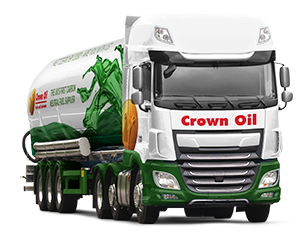Learn How Crude Oil is Refined into Useful Petroleum Products
Fractional distillation of crude oil is the process by which we obtain all the various petroleum products that we rely on from crude oil – whether that’s internal combustion engine fuels such as the petrol or diesel that fuels our cars’ engines; the gas oil powering machinery and furnaces; the jet fuel that fuels aircraft; or domestic and commercial heating oil that keeps our homes and workplaces warm.
In this guide, we’ll go through the diverse spectrum of petroleum products we obtain from crude oil fractional distillation as well as some of their applications.
You can also learn about some of these fuels in greater technical detail by reading our dedicated fuel specifications guide.
Crown Oil is an oil supplier, not an oil refiner, but with more than 75 years in the business, we’re one of the leaders in our industry, and our resident fuel experts have lots of knowledge to share; it’s through sharing our knowledge that you know you can trust us for your fuel and oil needs.
What is crude oil?
Crude oil is a naturally occurring viscous black oil. The raw material is made up of complex organic hydrocarbon structures and is formed from living matter that existed many millions of years ago, and in that time that matter has been processed by geological forces to create its current form of black oil. While it is sometimes found at the surface level, crude oil is mostly obtained by drilling for oil in the ground at oil wells on land, and at oil rigs at sea.
The majority of crude oil is drilled from oil fields in the Middle East, with the Kingdom of Saudi Arabia leading global production. Other major producers are Russia, China, Canada and the US.
In the UK, crude oil is imported mostly from Norway which supplies 40% of all the UK’s crude oil and the US, which supplies 26%. Other countries that export their petroleum to UK refineries in lower amounts include Algeria, Russia, Nigeria, and Saudi Arabia among other countries. Below is a table of where crude oil supplied to the UK came from in 2019:
| Source of UK crude oil imports | Quantity supplied (thousands of tonnes) | Percent of UK’s supply |
| Norway | 17,458 | 40% |
| United States | 11,405 | 26% |
| Algeria | 4,325 | 10% |
| Russia | 3,800 | 9% |
| Nigeria | 2,777 | 6% |
| Saudi Arabia | 1,024 | 2% |
| Libya | 793 | 2% |
| Canada | 628 | 1% |
| Netherlands | 484 | 1% |
| Rest of Africa | 255 | 1% |
| Egypt | 239 | 1% |
| Spain | 220 | 1% |
| Azerbaijan | 181 | 0% |
| Venezuela | 83 | 0% |
| Germany | 51 | 0% |
| Denmark | 33 | 0% |
| Total | 43,756 |
What is petroleum?
Petroleum is a broad term that refers to both crude oil and petroleum products. Petroleum products are the different hydrocarbon groups that occur within crude oil, and they are obtained through the refinement of crude oil.
What are hydrocarbons in crude oil?
Hydrocarbons are chains of carbon and hydrogen that make up all organic material – including crude oil. Along with water, hydrocarbon molecules are the building blocks of life. Crude oil is made up of many different types of hydrocarbon chains all mixed together. When these chains are separated into similar lengths, we have refined the crude oil into useful products.
A process called fractional distillation is used in oil refineries to separate (as well as join or split) the various lengths of hydrocarbon chains to create different petroleum products from the different distillates.
More technically…
The hydrocarbon chains that constitute petroleum fuel products are a family of hydrocarbons called alkanes, or paraffins, depending on their size. Alkanes are hydrocarbon chains with the chemical formula Cn+H2n+2. Alkanes are stable but versatile, making them safe for use and storage as a range of fuel products.
The simplest of these alkanes is a gas, methane, with a chemical makeup of CH4 (just one carbon atom); the next largest is ethane (C2H6), propane (C3H8) and butane (C4H10). From there, alkanes are named using Greek numerals to easily identify their structure, as we can see from examples such as pentane (C5H12), hexane (C6H14), heptane (C7H16), octane (C8H18). These alkanes can be hundreds of carbon atoms long.
Some alkanes are useful to know about at a technical level, specifically octane and cetane (sometimes called Hexadecane)(C16H34), as they are a measure of the performance of petrol (the octane number) and diesel fuel (the cetane number in diesel fuel technical specifications). Alkanes mixtures with a flashpoint of 42℃ are grouped as fuel oils.
At the same time, there are also alkenes, naphthenes and aromatics present in crude oil, which are used in chemical processes. Alkenes and naphthenes refer to hydrocarbons with a molecular formula of CnH2n but have different structures – alkanes being formed in a chain, and naphthenes in a ring.
What’s the difference between petroleum and crude oil?
While the two can be used interchangeably, when talking about the refinement and production of petroleum products, petroleum is a broad term that includes both crude oil and petroleum products. Crude oil refers to specifically the raw product drilled from the ground.
Fractional distillation and distillates
The process through which petroleum is refined is called fractional distillation and occurs in a distillation tower or fractionating column. Outside of the oil industry, fractional distillation is a process used for separating a mixture of two or more fluids of different densities by heating the mixture to the point of boiling. These separated fluids are the ‘distillates’.
In the context of oil refining, the distillates are the various products we use, such as petrol or diesel fuels or kerosene. Each of these products has a different density and form at different stages of the fractionating column – the least dense gases at the top, and the more dense heavy fuels and bitumen at the bottom.
How fractional distillation works
To distil products in this method involves boiling the mixture to release the different constituent liquids as gases. These gases rise up a fractionating column and condense at a cooler (higher) point in the column. Since less dense liquids and gases have lower boiling points, these condense at higher points in a column than the fluids of higher density. The fluids that form at a specific point of the column are known as ‘distillates’.
As well as the petrochemical production described above, a similar process applies to whiskey.
When it comes to the fractional distillation of crude oil, steamed hot water is used to boil the liquid in order to separate the distillates, and because crude oil is a complex liquid, there are many distillates that are obtained over a range of temperatures; the most popular are petrol, diesel, gas oil or red diesel and kerosene. Products are obtained at almost every temperature range, from 600°C at the bottom, where it is hottest, to the least dense distillates, the petroleum gases, which form at temperatures as low as 25°C.
In order to accommodate this large range of condensation zones, fractionating columns are quite tall: ranging from 0.5 to 6.0 metres in diameter and 6.0 to 60.0 metres tall, depending on the refinery.
Cracking, unifying and altering distillates
Mixtures of the various distillates in crude oil don’t exist in the ratio that we use them. For that reason, crude oil distillates can be cracked (broken down), unified (joined) or altered. This is a second stage that occurs after the distillate forms.
If, for example, more petrol is required, then longer chains (from fuel oil) can be cracked and added to the distillate. Alternatively, the chains from lighter gases can be unified to form petrol-length chains.
Oil refining in the UK
The UK has seven refineries and these have the capacity to process over 61 million tonnes of fuel every year (although 43.7 million tonnes were imported that year, as we saw above). Oil processed in these refineries is imported mainly from Norway, the US, Algeria and Russia. The refined oil products are then sold to oil distributors like Crown Oil to be distributed to businesses and homes around the county.
Typically in order to supply businesses with fuels, large fuel tankers are required as the volumes industrial usage requires are quite large – deliveries can be as large as 36,000 litres at a time!
Petroleum products obtained by fractional distillation of crude oil
There are many specialised products that are produced by refining petroleum, with the majority of petroleum going into engine fuels, such as petrol (gasoline); diesel and gas oil; and kerosene (for heating and for jet fuel) – but we’ll focus on the 16 most common for simplicity sake.
Because hydrocarbon chains (the alkanes we mentioned earlier) form over a range of temperatures, petroleum products are a mixture of various chains, with an average range of chain length.
Distillates are often grouped together based on certain similar characteristics: the lightest fluids are the ‘top distillates’; while the ‘middle distillates’ are fuels that are formed lower down the columns that have a flashpoint higher than 42℃. Below those are the ‘bunker fuels’ – heavier diesel fuels mostly used in maritime applications, while the ‘lower distillates’ are the lower-down products that are too heavy for fuel, and are used as lubricants, such as motor oil. The final group of distillates are the residuals – the products that are left behind as residue in the distillation process which is also put to use in industry.

The top distillates
The top of the fractionating column gives rise to gases and liquids that have short carbon chains in their composition. While these products are often used as fuels, many have industrial and chemical uses too.
Butane and propane and other petroleum gases are formed right at the top of the distillation tower, where it is coolest, a very mild 25°C: the temperature range that forms these gases is between 25°C and 50°C. These gases are the lightest products formed in crude oil distillation and are flammable gases.
These gases, being the lightest products formed and flammable gases too, are then processed into Liquified Petroleum Gas (LPG), which is usually a mixture of propane and butane. LPG is used for heating applications and also hot air balloons in the case of propane.
The petroleum gases have four or five hydrocarbons in their chain. For these distillates, hydrocarbon chains are made up of three carbon atoms in the case of propane (C3H8), and four carbon atoms in the case of butane (C4H10).
Petrol/gasoline is the most common automobile engine fuel and is also one of the lightest petroleum distillates. About 60 per cent of crude oil is refined into petrol, explaining why it is so necessary to find renewable alternatives. Petrol is a mixture of a variety of hydrocarbon types, but it forms high in the column at a temperature of 25°C up to 60℃. Being such a light product, petrol is a mixture of hydrocarbons of between four and 12 carbon atoms per molecule.
Slightly below petrol is naphtha which is produced for its use in the world of chemistry and industry, such as in plastic use, as well as fuel – such as lighter fluid. Naphtha hydrocarbons have a boiling point of 60°C to 100℃ and contain between five and 12 carbon atoms per molecule.
The middle distillate fuel oils
Oils below this point have a flashpoint of higher than 42°C and are classified as fuel oils. We explain fuel oils further in our fuel oil guide. These are the middle distillates as they form in the mid-section of the tower.
Used for heating and burning in domestic applications is paraffin and paraffin wax, which forms in the column at a range of 100°C to 175°C. Paraffin has between twenty and forty carbon atoms. Paraffin wax is further processed to be used in industry to create candles, petroleum jelly that protects skin and many other products.
While paraffin can also refer to kerosene, it comes as a result of paraffin’s history as a domestic heating fuel, for which kerosene is now the default.
Our guide to paraffin explains more about this product.
Produced where the temperature for condensation is 175°C to 250°C is kerosene. Kerosene as a distillate is used as home heating oil (BS 2869 grades C1 kerosene and C2 kerosene) and jet fuel (A1 jet fuel).
Because of these different uses, there is still extra processing the oil needs to undergo before it can make its way into furnaces and jet turbines. Kerosene chain lengths have various grades, ranging between five and 14 carbon atoms long for regular kerosene, to between six and 16 carbon atoms long for aviation-grade kerosene.
Did you know? Crown Oil has its roots in kerosene which used to be the default domestic heating oil. Our founder, Harry Greensmith was known around Bury and Heywood as ‘Harry Lamp Oil’ when he used to sell fuel for kerosene lamps door-to-door as far back as 1928.
Petroleum diesel, that is to say, the diesel used for ULSD (EN 590) DERV diesel for diesel-engined automobiles and BS 2869 gas oil Grades A2 gas oil and D grade gas oil for agricultural machinery and heating applications, has a versatile range of applications, so there are different grades for different tasks. Add to this, diesel is seasonally adjusted to provide optimal low-temperature performance (our fuel specification guide explains this in greater detail).
Diesel fuels condense over a range of boiling temperatures – around 250°C to 350°C.
Because of this, we’ve used the plural – there are a few specialised distillates that form in this area of the distillation tower. There isn’t one outlet for these different diesel engine fuels – but their outlets are near one another as their variations are small. Due to the multitude of applications for diesel fuels, there are many developments into alternative diesel fuels – some, like HVO fuel, are renewable and some, like GTL fuel, are much cleaner burning than petroleum diesel.
Lower distillates
At the bottom extremity of the fractioning tower, the lower distillates form. These have high densities, higher boiling points and are not used as fuels, but more as grease for lubrication. These form at temperatures of 350°C to 600°C.
Mineral-based lubricants for equipment and machinery often are distilled from this part of the fractionating column, the most common being motor oil. They are formed where the temperature of the column is 300°C to 350°C
Greases are an essential part of industrial applications but are not used for burning, they are used as lubricating oil and in fact, they cannot be flammable, so it’s important that these are produced to high standards.
Bunker fuels are marine diesel fuels, and there are few types that are specialised for different kinds of vessels, especially larger vessels since the majority of pleasure craft run on regular white diesel.
You can learn more in our dedicated guide to bunker fuel.
Marine gas oil is the most common form of fuel for vessels that are larger than pleasure craft, which run on regular diesel oil.
For the largest ocean-going vessels, heavy fuel oil has been the fuel of choice, although, since 2020, the International Maritime Organisation has changed regulations to phase out this fuel, in favour of the lighter, lower sulphur marine gas oil. Heavy fuel oil needs to be heated during storage.
Heavy fuel oils have boiling points ranging from 350°C to 500°C.
In between MGO and HFO are three additional maritime oils, MDO, IFO and MFO. These are produced by blending MGO with HFO in varied proportions.
Marine diesel oil is a blend of distilled diesel fuel and a small amount of heavy fuel oil (HFO).
Intermediate fuel oil is heavier still, being a blend of HFO and MGO, with more HFO than what MDO uses.
Marine fuel oil is still heavier as it contains more HFO in its blend. As a result, it is black in colour.
Residuals
When it comes to petroleum products that are produced to ultimately be burned, it’s essential that waste is absolutely minimised, so at the bottom of the distillation tower, where temperatures reach 500°C to 600°C, the residue of crude oil is retrieved and put to use.
Residue formed at the bottom of the fractionating column includes bitumen and asphalt.
Refined bitumen is made from the residue of petroleum refining, where the column is around 600°C. You’ll have come across it every day as it is an essential component of construction – used in tarring roads, sealing roofs and many other applications.
Bitumen also forms naturally – known as crude bitumen.
The final product produced from petroleum residue is asphalt – the remaining petroleum at the bottom of the fractionating column is mixed with gravel and used in construction.
Crown Oil’s range of petroleum products
Renewable alternatives to petroleum products
Whenever we talk about petroleum and its uses, it’s always essential to educate everyone about renewable alternatives to petroleum products as that’s the direction that the future of energy needs to head in. Meanwhile, Crown Oil is proud of its commitment to a balanced carbon cycle and a renewable future by taking actions to become a greener, more sustainable business and by supplying the following green fuels:
If you would like to learn more, or looking for delivery of both fuel and oil products as well as alternative fuels, contact our fuel experts today on 0330 123 1444.





